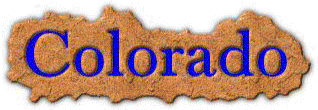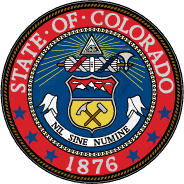
Entered Union: August 1, 1876; 38th State



By statute, the seal of the State is two and one-half inches in diameter with the following devices inscribed thereon: At the top is the eye of God within a trangle, from which golden rays radiate on two sides. Below the eye is a scroll, the Roman fasces, a bundle of birch or elm rods with a battle axe bound together by red thongs and bearing on a band of red, white and blue, the word, "Union and Constitution." The Roman fasces is the insignia of a republican form of government. The bundle of rods bound together symbolizes strength which is lacking in the single rod. The axe symbolizes authority and leadership. Below the scroll is the heraldic shield bearing across the top on a red ground three snow-capped mountains with clouds above them. The lower half of the shield has two miner's tools, the pick and sledge hammer, crossed on a golden ground. Below the shield in a semicircle is the motto, "Nil Sine Numine", Latin words meaning "nothing without the Deity", and at the bottom the figures 1876, the year Colorado came into statehood.
The design for the Territorial Seal which served as a model for the State Seal or Great Seal of Colorado has been variously credited, but the individual primarily responsible was Lewis Ledyard Weld, the Territorial Secretary, appointed by President Lincoln in July of 1861. There is also evidence that Territorial Governor William Gilpin also was at least partially responsible for the design. Both Weld and Gilpin were knowledgable in the art and symbolism of heraldry. Elements of design from both the Weld and Gilpin family coat-of-arms are incorporated in the Territorial Seal.
Nil Sine Numine
The Latin phrase "Nil Sine Numine", was adopted as part of the Territorial Seal. At recurring intervals, discussion has ensued concerning interpretation of this Latin phrase which commonly translated is "Nothing without Providence". Others say it is "Nothing without God". In the early mining days of the State, the unregenerate said it meant "nothing without a new mine". In a strict sense, one cannot possibly get "God" from "numine", God being a purely Anglo-Saxon word. The word "numine" means any divinity, god or goddess. The best evidence of intent of Colorado's official designers and framers of the resolution for adoption of the seal is contained in the committee report wherein clear distinction was made between "numine" and "Deo" and it is specifically states that the committee's interpretative translation was "Nothing without the Deity".
The Icons below will guide you to the other Colorado Pages |
|